2008 CHEVROLET CORVETTE traction control
[x] Cancel search: traction controlPage 92 of 432
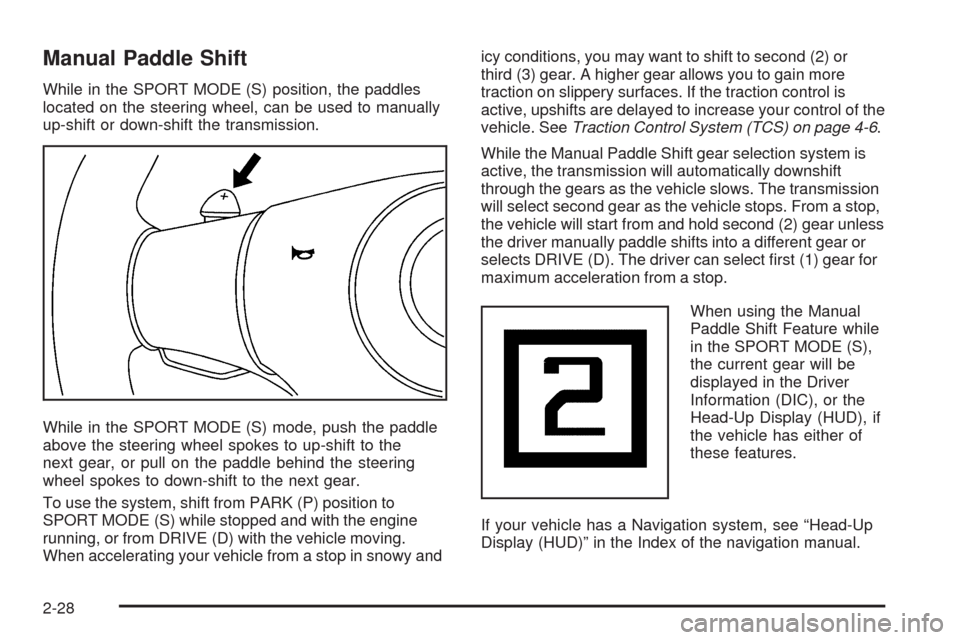
Manual Paddle Shift
While in the SPORT MODE (S) position, the paddles
located on the steering wheel, can be used to manually
up-shift or down-shift the transmission.
While in the SPORT MODE (S) mode, push the paddle
above the steering wheel spokes to up-shift to the
next gear, or pull on the paddle behind the steering
wheel spokes to down-shift to the next gear.
To use the system, shift from PARK (P) position to
SPORT MODE (S) while stopped and with the engine
running, or from DRIVE (D) with the vehicle moving.
When accelerating your vehicle from a stop in snowy andicy conditions, you may want to shift to second (2) or
third (3) gear. A higher gear allows you to gain more
traction on slippery surfaces. If the traction control is
active, upshifts are delayed to increase your control of the
vehicle. SeeTraction Control System (TCS) on page 4-6.
While the Manual Paddle Shift gear selection system is
active, the transmission will automatically downshift
through the gears as the vehicle slows. The transmission
will select second gear as the vehicle stops. From a stop,
the vehicle will start from and hold second (2) gear unless
the driver manually paddle shifts into a different gear or
selects DRIVE (D). The driver can select �rst (1) gear for
maximum acceleration from a stop.
When using the Manual
Paddle Shift Feature while
in the SPORT MODE (S),
the current gear will be
displayed in the Driver
Information (DIC), or the
Head-Up Display (HUD), if
the vehicle has either of
these features.
If your vehicle has a Navigation system, see “Head-Up
Display (HUD)” in the Index of the navigation manual.
2-28
Page 137 of 432
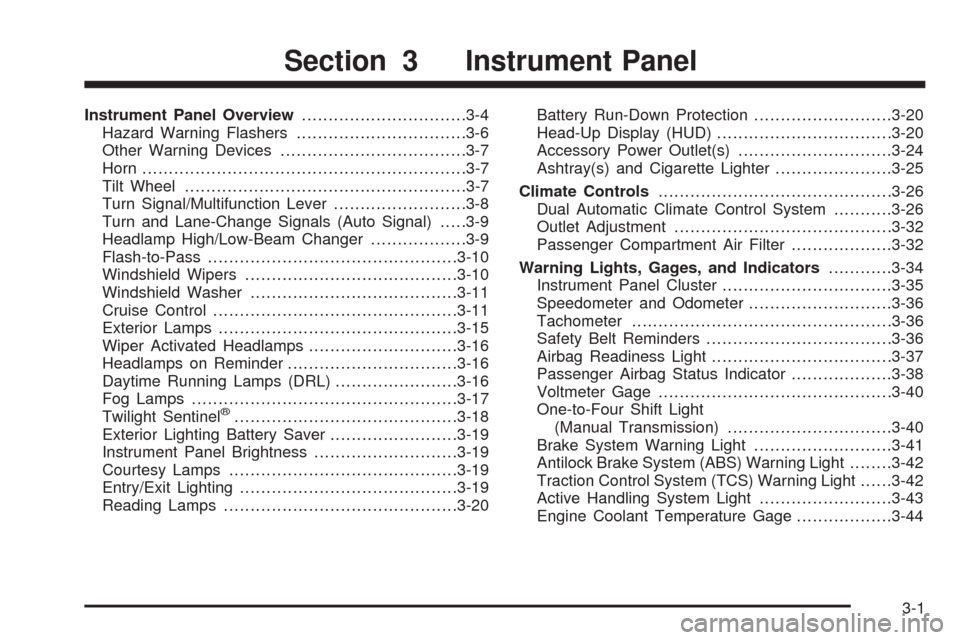
Instrument Panel Overview...............................3-4
Hazard Warning Flashers................................3-6
Other Warning Devices...................................3-7
Horn .............................................................3-7
Tilt Wheel.....................................................3-7
Turn Signal/Multifunction Lever.........................3-8
Turn and Lane-Change Signals (Auto Signal).....3-9
Headlamp High/Low-Beam Changer..................3-9
Flash-to-Pass...............................................3-10
Windshield Wipers........................................3-10
Windshield Washer.......................................3-11
Cruise Control..............................................3-11
Exterior Lamps.............................................3-15
Wiper Activated Headlamps............................3-16
Headlamps on Reminder................................3-16
Daytime Running Lamps (DRL).......................3-16
Fog Lamps ..................................................3-17
Twilight Sentinel
®..........................................3-18
Exterior Lighting Battery Saver........................3-19
Instrument Panel Brightness...........................3-19
Courtesy Lamps...........................................3-19
Entry/Exit Lighting.........................................3-19
Reading Lamps............................................3-20Battery Run-Down Protection..........................3-20
Head-Up Display (HUD).................................3-20
Accessory Power Outlet(s).............................3-24
Ashtray(s) and Cigarette Lighter......................3-25
Climate Controls............................................3-26
Dual Automatic Climate Control System...........3-26
Outlet Adjustment.........................................3-32
Passenger Compartment Air Filter...................3-32
Warning Lights, Gages, and Indicators............3-34
Instrument Panel Cluster................................3-35
Speedometer and Odometer...........................3-36
Tachometer.................................................3-36
Safety Belt Reminders...................................3-36
Airbag Readiness Light..................................3-37
Passenger Airbag Status Indicator...................3-38
Voltmeter Gage............................................3-40
One-to-Four Shift Light
(Manual Transmission)...............................3-40
Brake System Warning Light..........................3-41
Antilock Brake System (ABS) Warning Light........3-42
Traction Control System (TCS) Warning Light......3-42
Active Handling System Light.........................3-43
Engine Coolant Temperature Gage..................3-44
Section 3 Instrument Panel
3-1
Page 148 of 432
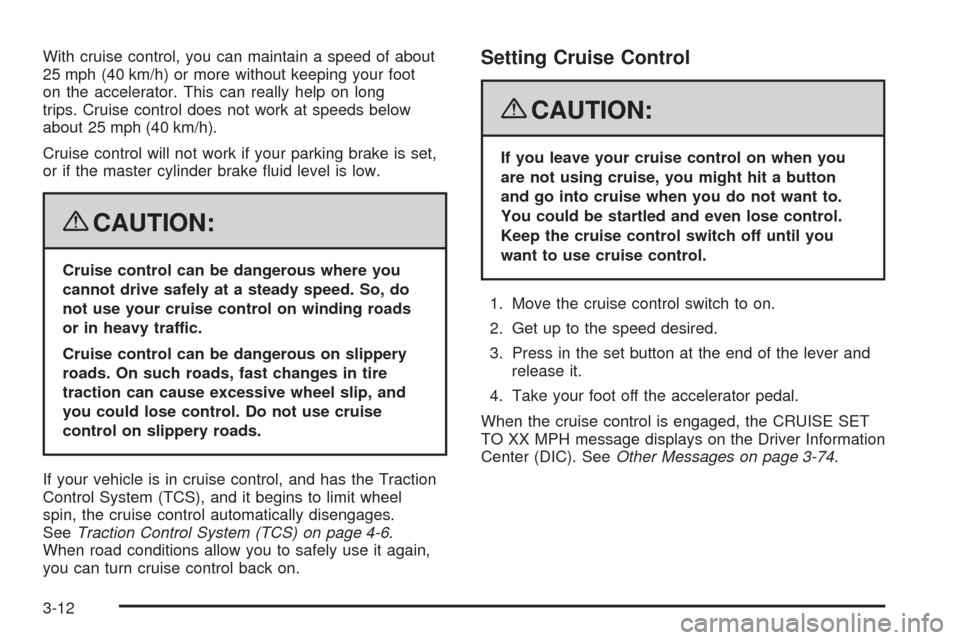
With cruise control, you can maintain a speed of about
25 mph (40 km/h) or more without keeping your foot
on the accelerator. This can really help on long
trips. Cruise control does not work at speeds below
about 25 mph (40 km/h).
Cruise control will not work if your parking brake is set,
or if the master cylinder brake �uid level is low.
{CAUTION:
Cruise control can be dangerous where you
cannot drive safely at a steady speed. So, do
not use your cruise control on winding roads
or in heavy traffic.
Cruise control can be dangerous on slippery
roads. On such roads, fast changes in tire
traction can cause excessive wheel slip, and
you could lose control. Do not use cruise
control on slippery roads.
If your vehicle is in cruise control, and has the Traction
Control System (TCS), and it begins to limit wheel
spin, the cruise control automatically disengages.
SeeTraction Control System (TCS) on page 4-6.
When road conditions allow you to safely use it again,
you can turn cruise control back on.
Setting Cruise Control
{CAUTION:
If you leave your cruise control on when you
are not using cruise, you might hit a button
and go into cruise when you do not want to.
You could be startled and even lose control.
Keep the cruise control switch off until you
want to use cruise control.
1. Move the cruise control switch to on.
2. Get up to the speed desired.
3. Press in the set button at the end of the lever and
release it.
4. Take your foot off the accelerator pedal.
When the cruise control is engaged, the CRUISE SET
TO XX MPH message displays on the Driver Information
Center (DIC). SeeOther Messages on page 3-74.
3-12
Page 178 of 432
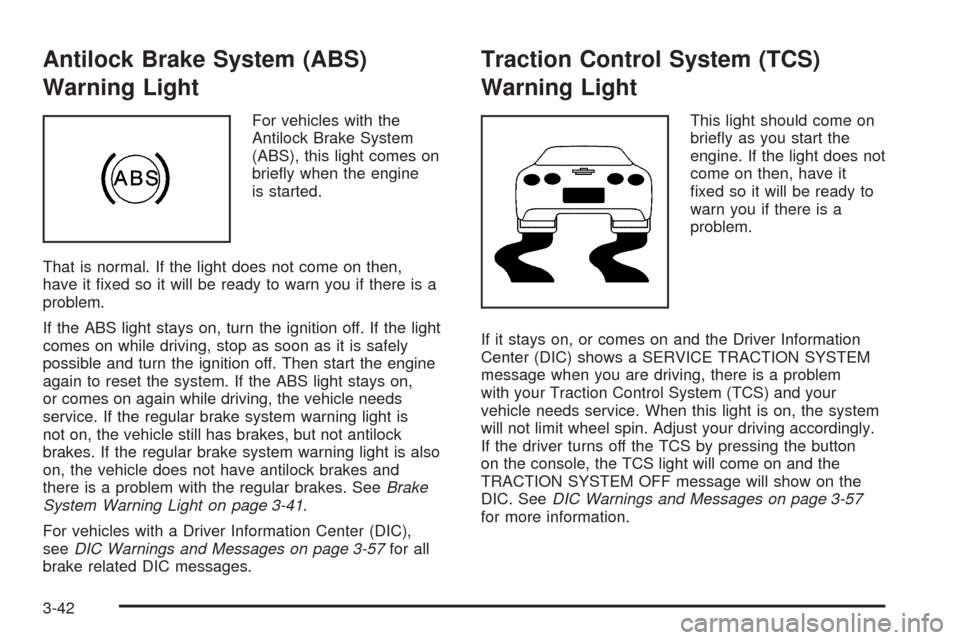
Antilock Brake System (ABS)
Warning Light
For vehicles with the
Antilock Brake System
(ABS), this light comes on
brie�y when the engine
is started.
That is normal. If the light does not come on then,
have it �xed so it will be ready to warn you if there is a
problem.
If the ABS light stays on, turn the ignition off. If the light
comes on while driving, stop as soon as it is safely
possible and turn the ignition off. Then start the engine
again to reset the system. If the ABS light stays on,
or comes on again while driving, the vehicle needs
service. If the regular brake system warning light is
not on, the vehicle still has brakes, but not antilock
brakes. If the regular brake system warning light is also
on, the vehicle does not have antilock brakes and
there is a problem with the regular brakes. SeeBrake
System Warning Light on page 3-41.
For vehicles with a Driver Information Center (DIC),
seeDIC Warnings and Messages on page 3-57for all
brake related DIC messages.
Traction Control System (TCS)
Warning Light
This light should come on
brie�y as you start the
engine. If the light does not
come on then, have it
�xed so it will be ready to
warn you if there is a
problem.
If it stays on, or comes on and the Driver Information
Center (DIC) shows a SERVICE TRACTION SYSTEM
message when you are driving, there is a problem
with your Traction Control System (TCS) and your
vehicle needs service. When this light is on, the system
will not limit wheel spin. Adjust your driving accordingly.
If the driver turns off the TCS by pressing the button
on the console, the TCS light will come on and the
TRACTION SYSTEM OFF message will show on the
DIC. SeeDIC Warnings and Messages on page 3-57
for more information.
3-42
Page 179 of 432
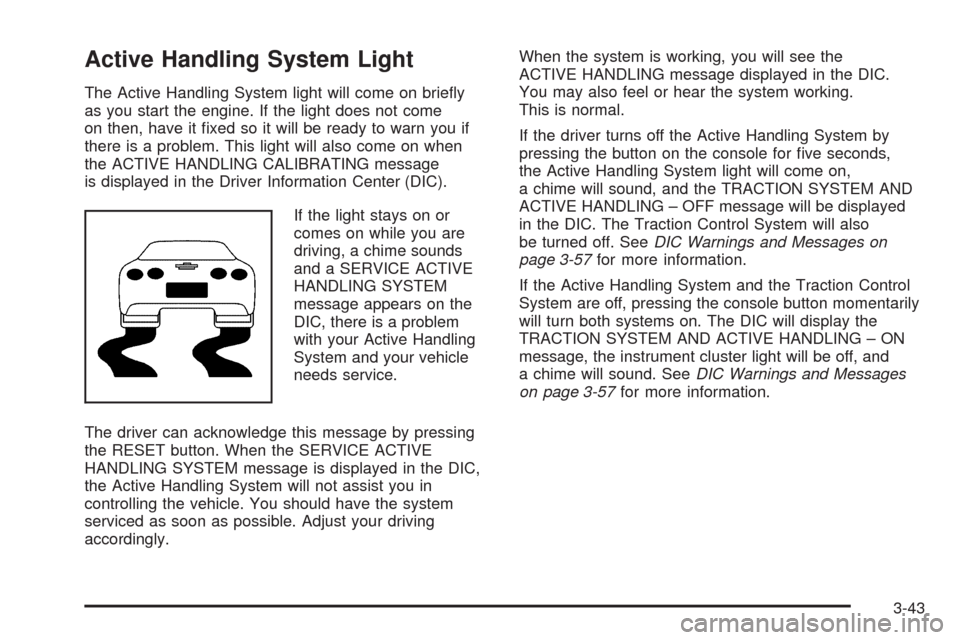
Active Handling System Light
The Active Handling System light will come on brie�y
as you start the engine. If the light does not come
on then, have it �xed so it will be ready to warn you if
there is a problem. This light will also come on when
the ACTIVE HANDLING CALIBRATING message
is displayed in the Driver Information Center (DIC).
If the light stays on or
comes on while you are
driving, a chime sounds
and a SERVICE ACTIVE
HANDLING SYSTEM
message appears on the
DIC, there is a problem
with your Active Handling
System and your vehicle
needs service.
The driver can acknowledge this message by pressing
the RESET button. When the SERVICE ACTIVE
HANDLING SYSTEM message is displayed in the DIC,
the Active Handling System will not assist you in
controlling the vehicle. You should have the system
serviced as soon as possible. Adjust your driving
accordingly.When the system is working, you will see the
ACTIVE HANDLING message displayed in the DIC.
You may also feel or hear the system working.
This is normal.
If the driver turns off the Active Handling System by
pressing the button on the console for �ve seconds,
the Active Handling System light will come on,
a chime will sound, and the TRACTION SYSTEM AND
ACTIVE HANDLING – OFF message will be displayed
in the DIC. The Traction Control System will also
be turned off. SeeDIC Warnings and Messages on
page 3-57for more information.
If the Active Handling System and the Traction Control
System are off, pressing the console button momentarily
will turn both systems on. The DIC will display the
TRACTION SYSTEM AND ACTIVE HANDLING – ON
message, the instrument cluster light will be off, and
a chime will sound. SeeDIC Warnings and Messages
on page 3-57for more information.
3-43
Page 197 of 432
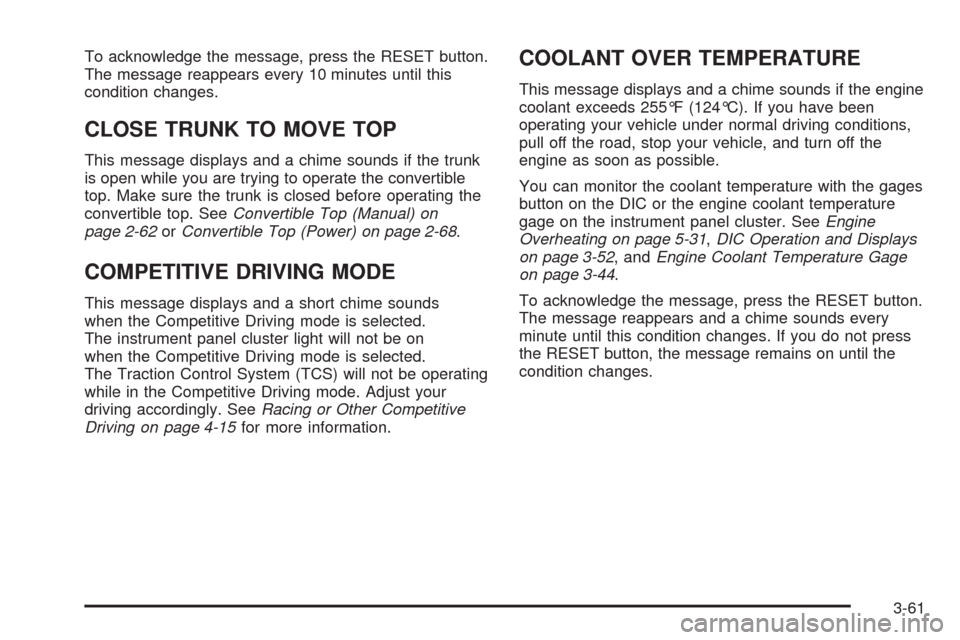
To acknowledge the message, press the RESET button.
The message reappears every 10 minutes until this
condition changes.
CLOSE TRUNK TO MOVE TOP
This message displays and a chime sounds if the trunk
is open while you are trying to operate the convertible
top. Make sure the trunk is closed before operating the
convertible top. SeeConvertible Top (Manual) on
page 2-62orConvertible Top (Power) on page 2-68.
COMPETITIVE DRIVING MODE
This message displays and a short chime sounds
when the Competitive Driving mode is selected.
The instrument panel cluster light will not be on
when the Competitive Driving mode is selected.
The Traction Control System (TCS) will not be operating
while in the Competitive Driving mode. Adjust your
driving accordingly. SeeRacing or Other Competitive
Driving on page 4-15for more information.
COOLANT OVER TEMPERATURE
This message displays and a chime sounds if the engine
coolant exceeds 255°F (124°C). If you have been
operating your vehicle under normal driving conditions,
pull off the road, stop your vehicle, and turn off the
engine as soon as possible.
You can monitor the coolant temperature with the gages
button on the DIC or the engine coolant temperature
gage on the instrument panel cluster. SeeEngine
Overheating on page 5-31,DIC Operation and Displays
on page 3-52, andEngine Coolant Temperature Gage
on page 3-44.
To acknowledge the message, press the RESET button.
The message reappears and a chime sounds every
minute until this condition changes. If you do not press
the RESET button, the message remains on until the
condition changes.
3-61
Page 203 of 432
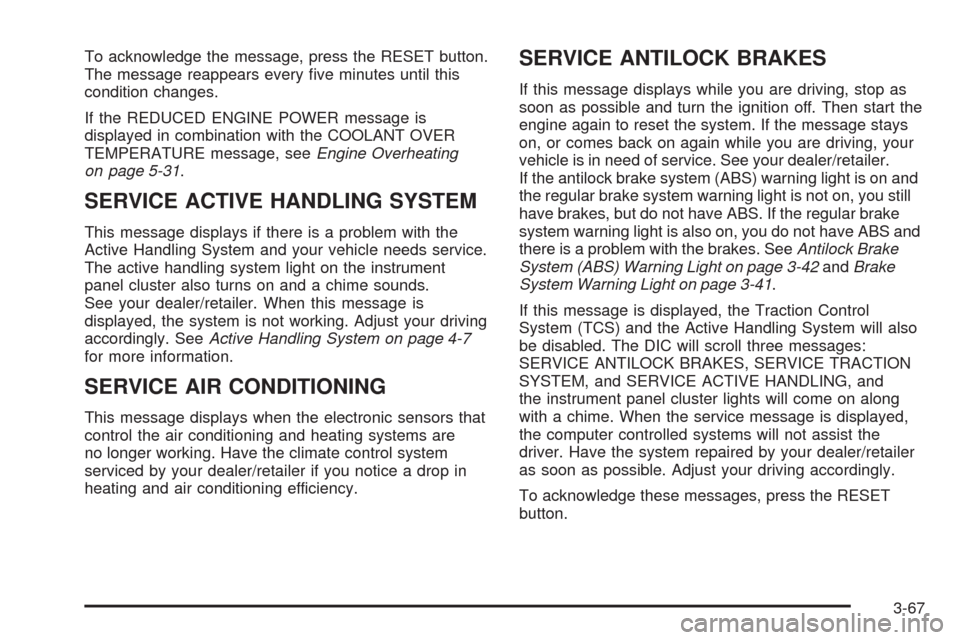
To acknowledge the message, press the RESET button.
The message reappears every �ve minutes until this
condition changes.
If the REDUCED ENGINE POWER message is
displayed in combination with the COOLANT OVER
TEMPERATURE message, seeEngine Overheating
on page 5-31.
SERVICE ACTIVE HANDLING SYSTEM
This message displays if there is a problem with the
Active Handling System and your vehicle needs service.
The active handling system light on the instrument
panel cluster also turns on and a chime sounds.
See your dealer/retailer. When this message is
displayed, the system is not working. Adjust your driving
accordingly. SeeActive Handling System on page 4-7
for more information.
SERVICE AIR CONDITIONING
This message displays when the electronic sensors that
control the air conditioning and heating systems are
no longer working. Have the climate control system
serviced by your dealer/retailer if you notice a drop in
heating and air conditioning efficiency.
SERVICE ANTILOCK BRAKES
If this message displays while you are driving, stop as
soon as possible and turn the ignition off. Then start the
engine again to reset the system. If the message stays
on, or comes back on again while you are driving, your
vehicle is in need of service. See your dealer/retailer.
If the antilock brake system (ABS) warning light is on and
the regular brake system warning light is not on, you still
have brakes, but do not have ABS. If the regular brake
system warning light is also on, you do not have ABS and
there is a problem with the brakes. SeeAntilock Brake
System (ABS) Warning Light on page 3-42andBrake
System Warning Light on page 3-41.
If this message is displayed, the Traction Control
System (TCS) and the Active Handling System will also
be disabled. The DIC will scroll three messages:
SERVICE ANTILOCK BRAKES, SERVICE TRACTION
SYSTEM, and SERVICE ACTIVE HANDLING, and
the instrument panel cluster lights will come on along
with a chime. When the service message is displayed,
the computer controlled systems will not assist the
driver. Have the system repaired by your dealer/retailer
as soon as possible. Adjust your driving accordingly.
To acknowledge these messages, press the RESET
button.
3-67
Page 205 of 432
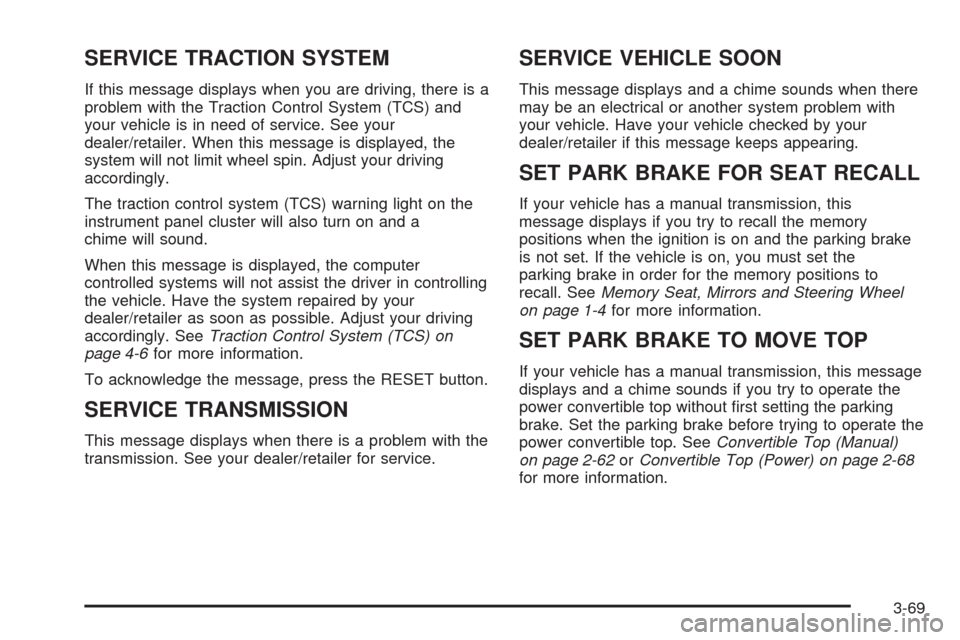
SERVICE TRACTION SYSTEM
If this message displays when you are driving, there is a
problem with the Traction Control System (TCS) and
your vehicle is in need of service. See your
dealer/retailer. When this message is displayed, the
system will not limit wheel spin. Adjust your driving
accordingly.
The traction control system (TCS) warning light on the
instrument panel cluster will also turn on and a
chime will sound.
When this message is displayed, the computer
controlled systems will not assist the driver in controlling
the vehicle. Have the system repaired by your
dealer/retailer as soon as possible. Adjust your driving
accordingly. SeeTraction Control System (TCS) on
page 4-6for more information.
To acknowledge the message, press the RESET button.
SERVICE TRANSMISSION
This message displays when there is a problem with the
transmission. See your dealer/retailer for service.
SERVICE VEHICLE SOON
This message displays and a chime sounds when there
may be an electrical or another system problem with
your vehicle. Have your vehicle checked by your
dealer/retailer if this message keeps appearing.
SET PARK BRAKE FOR SEAT RECALL
If your vehicle has a manual transmission, this
message displays if you try to recall the memory
positions when the ignition is on and the parking brake
is not set. If the vehicle is on, you must set the
parking brake in order for the memory positions to
recall. SeeMemory Seat, Mirrors and Steering Wheel
on page 1-4for more information.
SET PARK BRAKE TO MOVE TOP
If your vehicle has a manual transmission, this message
displays and a chime sounds if you try to operate the
power convertible top without �rst setting the parking
brake. Set the parking brake before trying to operate the
power convertible top. SeeConvertible Top (Manual)
on page 2-62orConvertible Top (Power) on page 2-68
for more information.
3-69